Follow these eCommerce marketing strategy examples to help you grow your store and make more sales.
There’s no button that grows your eCommerce business when pressed.
There’s no single strategy, no magic formula that gets you thousands of dollars in sales overnight.
There are, however, proven strategies that can increase the chance of your business growing and succeeding.
There are recommendations taken from businesses that have implemented a strategy and found success with it. Some of them are high-investment. Some take only a couple minutes and the right tool.
In this article, I’ll show you 30 eCommerce marketing strategy examples to help inspire your next campaign. These are real-world examples from businesses that have tested and implemented these strategies for themselves.
Without further ado, let’s dive right in.
Ecommerce Marketing Strategy #1: Run a Seasonal Promotion
Tapping into what your followers and target market are thinking about is a great way to increase engagement with a campaign or promotion. Christmas? Run a Christmas-oriented promotion or giveaway. Back-to-School? Run a promotion giving away a student-oriented shopping spree. Arbor Day? National Hotdog Day? It doesn’t matter. Contests are always more successful when they’re based around a theme.
Here’s an example of a seasonal email promotion (Halloween) from Starbucks:
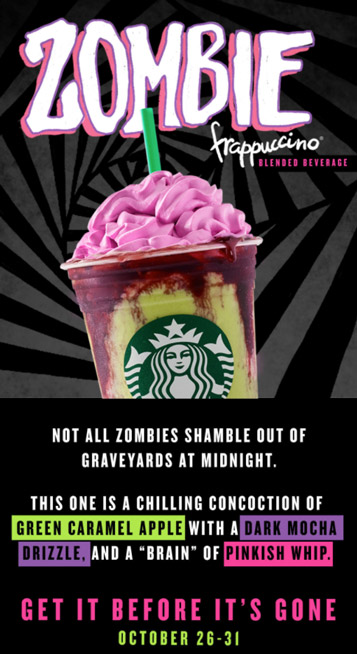
And here’s an example of a seasonal contest page (Christmas) from Pittch socks:

For more on this….
Check out “30 Christmas Contest Ideas: Everything you Need to Succeed this Holiday Season” or “How to Run a Successful Contest.”
Ecommerce Marketing Strategy #2: Run a Fan-Only Campaign
Your Facebook followers aren’t worth all that much unless they become customers. Unfortunately, you could publish 100 Facebook posts before driving even a couple of followers to your website and from there to your checkout page.
The best option for monetizing Facebook, therefore, is to incentivize your existing fans to become business leads or customers. And the best way to do that is through a fan-only contest.
Here’s an example of a Fan-only contest post:

For more on this…
Check out my article “How to Use a Fan-Only Promotion to Turn Followers into Leads.”
Ecommerce Marketing Strategy #3: Use Live Video on Facebook to Increase Organic Reach
Live video has proven in the past couple years to be the most reliable way to boost your organic reach on Facebook. Facebook wants to compete with other social media platforms offering live video, so they’ll continue to reward publishers who go Live.
Here’s a snapshot of our own Facebook insights. Can you guess which one of these posts was a live video?
Ecommerce Marketing Strategy #4: Target People Using Locations
There’s no point in paying to make people in Pennsylvania aware of your local shoe store if you’re based in Seattle.
So, when you’re advertising with Google, be sure you limit your exposure. Otherwise, you’re just throwing money down the drain.
Here’s how it looks within the ad process:
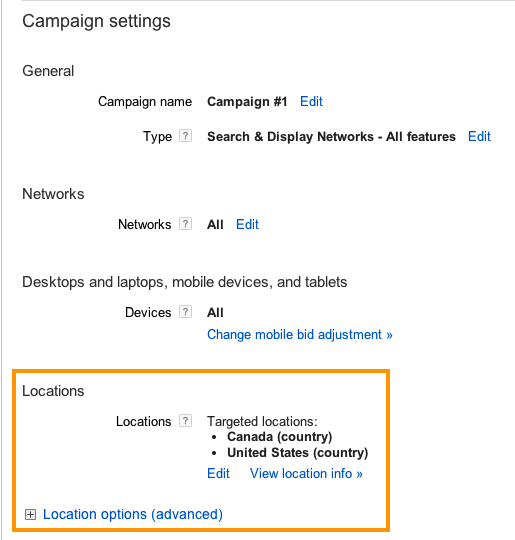
And here’s an example of local ads showing for a generic search:
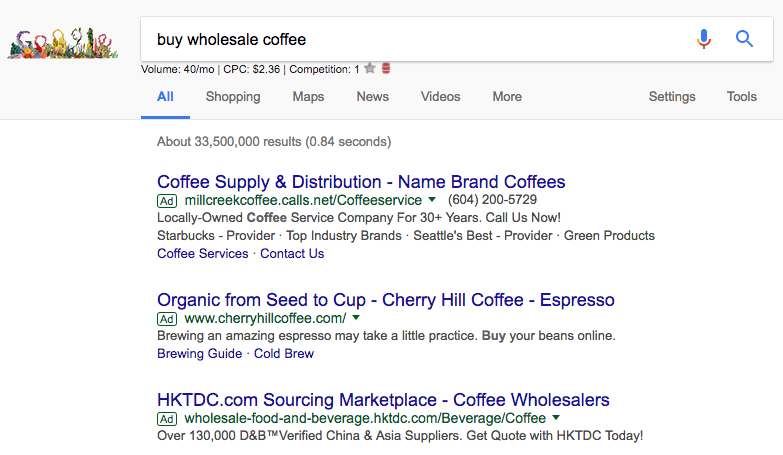
Want to learn more about local marketing?
Check out our in-depth local marketing guide.
Ecommerce Marketing Strategy #5: Run a Referral Contest to Drive Brand Awareness
Getting the most out of social media is about finding a way to monetize it – finding a way to tap into the millions of users without paying through the nose.
A referral contest, in which contest entrants are incentivized to share the campaign with their own networks by making sharing a crucial component of winning, is a great way to do this.
Essentially, your entrants are given a unique share URL which, when used by someone else to enter, gives points to the original sharer. It looks like this:

Ecommerce Marketing Strategy #6: Create a Bonus Entry Contest to Increase Social Media Engagement
Looking to boost the success of your social media page or drive awareness about a campaign you’re running? Creating a bonus entry component is a great way to do it.
A bonus entry contest functions by rewarding contest entrants with additional entries (chances to win) when they engage with your business on social media or share the contest. For instance, you’d give entrants +2 entries if they Follow your brand on Instagram or share your contest via email.
Below is a snapshot of a bonus entry component embedded in a click popup. As soon as someone enters the campaign and clicks “submit,” this popup would appear and prompt them to share and engage.
Here’s the example:

Ecommerce Marketing Strategy #7: Use an Instagram Monetization Platform to Enable People to Buy
Instagram, as the most visual social media platform, is amazing for eCommerce companies (us poor software companies have to resort to LinkedIn and blogging). The only challenge is driving people from your beautiful posts to a website that converts them.
That’s where an Instagram monetization platform comes in.
These platforms enable your business to drive traffic from a URL in your bio to a subdomain… Honestly, it’s easier to explain to watch the video.
Here’s an example from Canadian tea company David’s Tea from their Instagram profile.

For more on this…
Check out our article “Instagram Marketing: 20 Excellent Examples & Ideas from Top Brands.” Alternatively, check out “How to Create an Instagram Marketing Strategy.”
Ecommerce Marketing Strategy #8: Retarget Readers Of a Specific Piece of Content
This is one of my favorite eCommerce marketing strategies, and it’s especially relevant for those of you out there selling to multiple target audiences.
Let’s say that you’re doing eCommerce content marketing right. You’re creating guides to “fall fashion” or “how to’s” based on your products.
Below is an example of what I’m talking about. This is a Facebook post from Home Depot:

Clicking on the link in that post sends you to a simple landing page/article on the Home Depot website:
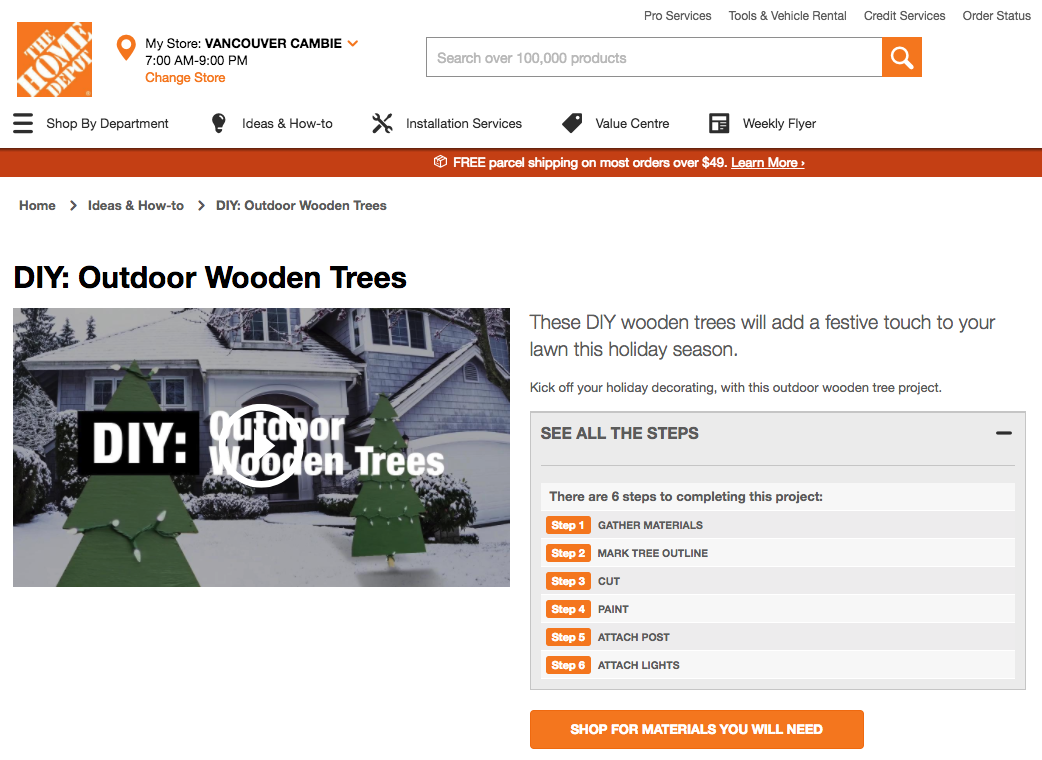
An eCommerce marketing strategy I’ve rarely seen used is retargeting the people who view this page with an ad relevant to what they’ve shown they’re interested in (this specific product/how-to).
For instance, if I looked at that article on Home Depot’s website, they could retarget me with this…
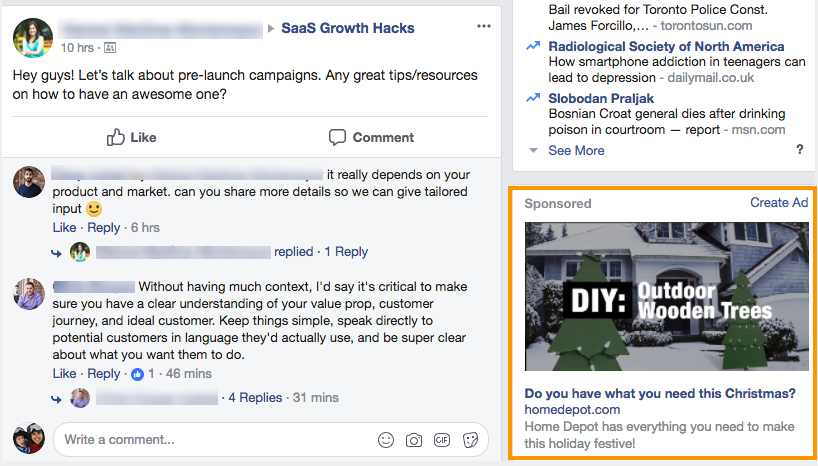
For more on this…
Check out Facebook’s Dynamic Ad Walkthrough. This is a walkthrough of how to create personalized ads that feature your product image.
Ecommerce Marketing Strategy #9: Drive Referral Traffic From Your Customers
I mentioned before the value of testimonials and reviews. This is because you’re not a trustworthy source of information on how awesome your products are. This is also why a referral from your existing customers is super impactful when it comes to driving people to buy something.
Encouraging your existing customers to refer a friend is a bit of a challenge, unless you throw in a carrot…
Here’s an example of a referral campaign:
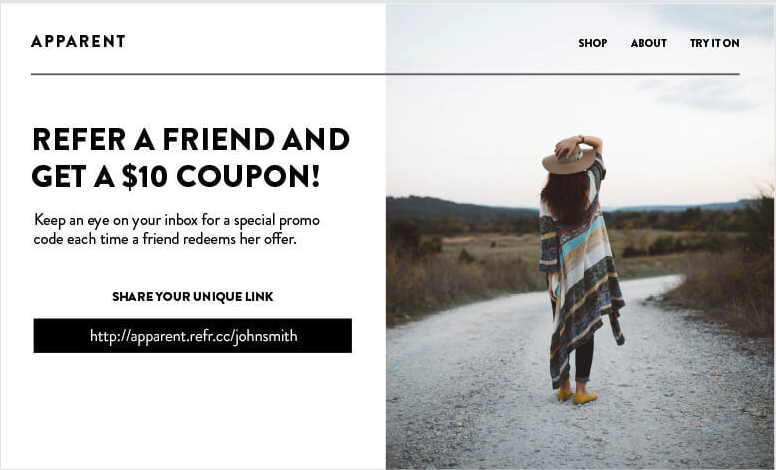
Relevant tools which will help you reward your customers for driving their friends to your eCommerce company include (but are not limited to) Viral Loops, ReferralCandy, Smile.io, and Ambassador
Ecommerce Marketing Strategy #10: Use a Leaderboard Contest to Drive Competition (and Shares)
Leaderboard contests work by showing contest entrants their standing within the campaign. This increases the competitiveness and results in entrants sharing and completing social actions more frequently.
Your contests already look great, so success is really about driving traffic and increasing awareness. While you can do that with advertising, it’s far cheaper (and far more effective) to have your contest entrants share your contest for you.
Here’s an example of a leaderboard contest in action (notice the “bonus entry” actions at the top, which determine an entrant’s points within the campaign):
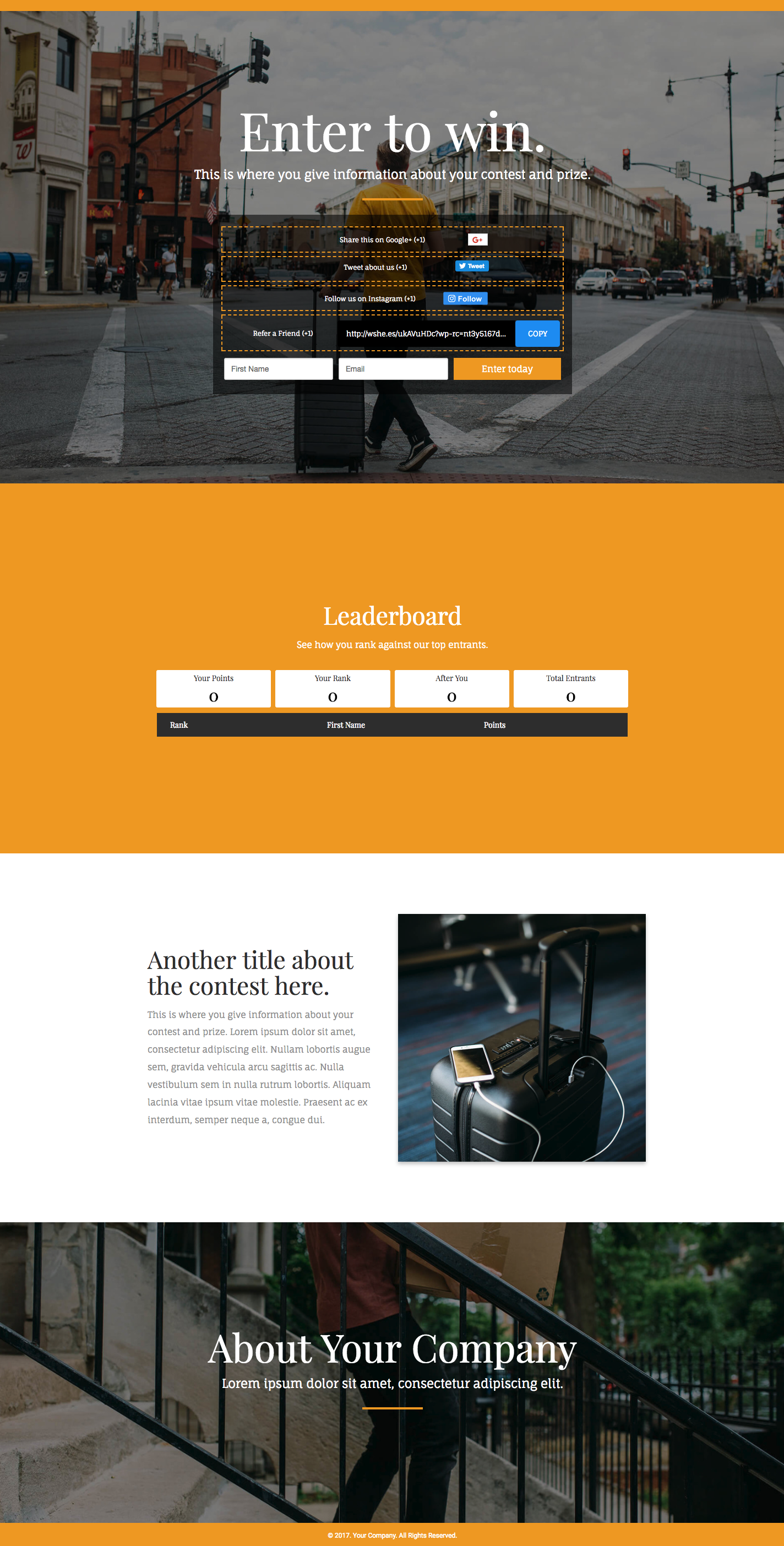
Ecommerce Marketing Strategy #11: Focus Attention On Your Promotion With a Hello-Bar or Slide-in Popup
The last thing you want is for a website visitor to leave your website unaware of the fact that you were running a “50% off” promotion or that they could get free shipping with their first purchase.
A leading strategy to make your visitors aware of your promotion (or opt-in incentives) is to put a hello bar or slide-in popup on your product pages and homepage. They show your promotion without massively interrupting the buying experience.
Here’s an example of a hello bar from Best Buy:
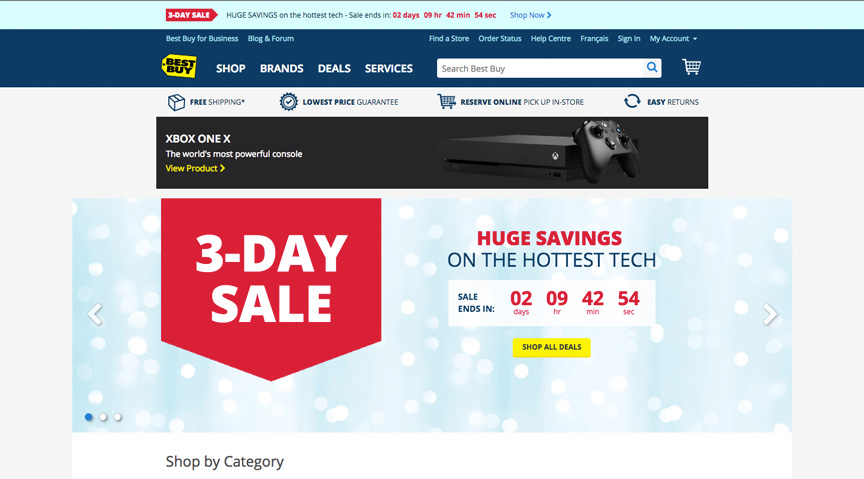
And here’s an example of a slide-in popup:
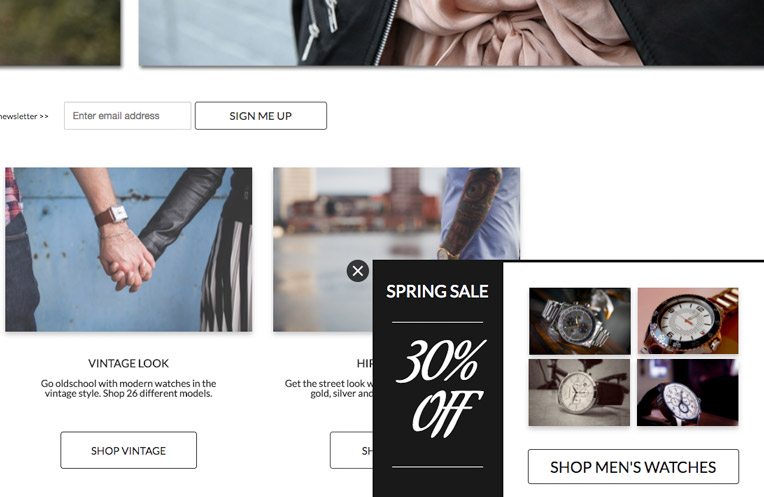
Ecommerce Marketing Strategy #12: Use an Entry Overlay or Welcome Mat
For those businesses who want to push a little harder – those businesses who want to be confident that 100% of your visitors will see their promotion – there’s the option of an entry overlay or welcome mat.
The difference between this strategy and the hello-bar/slide-in popup above is that visitors are required to engage. They have to close the popup or welcome mat in order to continue to your website.
Here’s an example of an entry overlay from DodoCase:
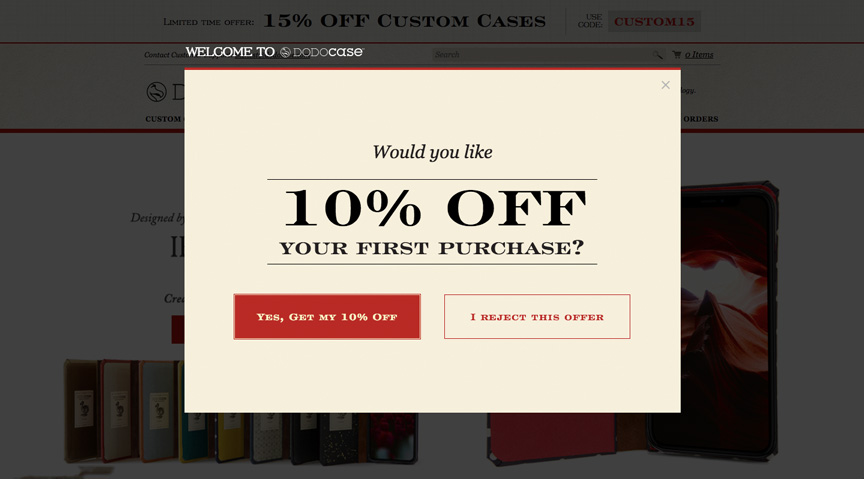
Ecommerce Marketing Strategy #13: Add a Countdown Timer to Your Promotion and Product Pages
An offer only being available for a limited time is a powerful motivator for conversion.
If I’m just browsing (as most online shoppers are), and I see something I want, I’ll note it in my head and (maybe) come back later.
But if I’m browsing and I see a great price which is only available for the next few hours? Then I need to buy to get this amazing deal.
Here’s an example of a limited-time promotion offering coupon codes to Facebook Fans:

Ecommerce Marketing Strategy #14: Get Testimonials and Reviews
When it comes to your own products, you’re biased.
Why should your customer, then, trust you when you say, “These socks are super comfortable.” Of course you would say that. You get the money when I pay for your socks…
A previous customer though? That’s different. They don’t have the same skin in the game that you do. If they tell me that your socks are super comfortable, why would they lie?
This is the value of testimonials and reviews. And on your product pages, there’s nothing more valuable than featuring unbiased reviews of your eCommerce product.
Here’s an example of testimonials on a product page from Canadian outdoor outfitter MEC:
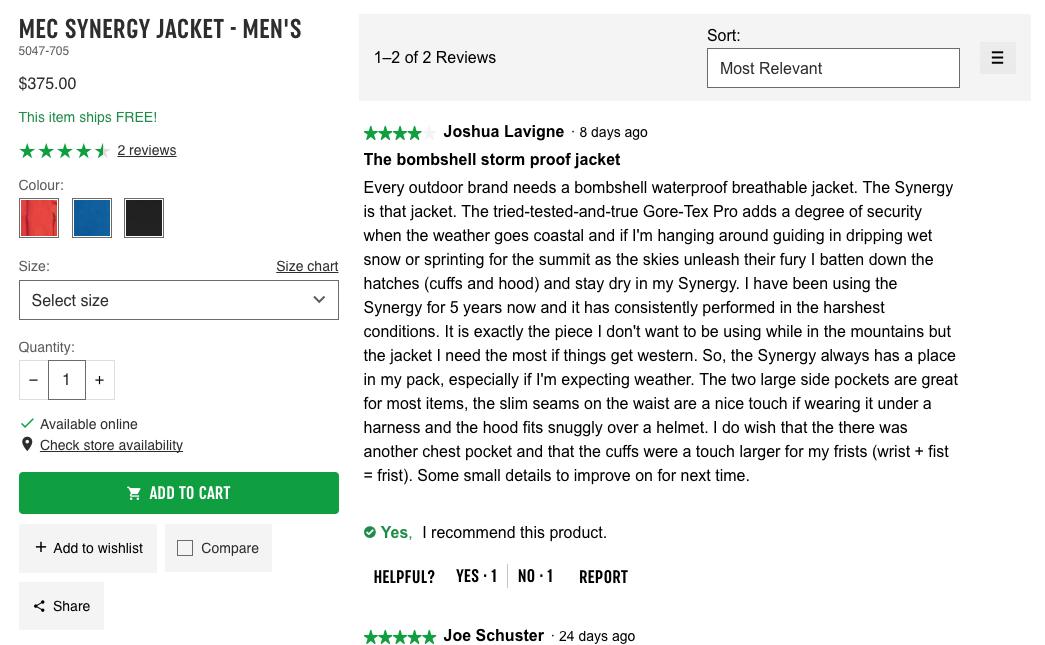
Ecommerce Marketing Strategy #15: Add an Exit Popup to Your Checkout Page
Often people leave your eCommerce shopping cart for no better reason than they aren’t quite (mentally) prepared to buy. They see the value of your product. They have the money and aren’t worried about the cost. Sometimes it’s just because they only wanted to look and are going to make a purchase later (only they forget or go somewhere else).
This is where an exit popup comes in. It’s not about introducing more value but making your visitors truly aware they are leaving.
All you need is something like the example below, to jog them out of their existing mindset of leaving:
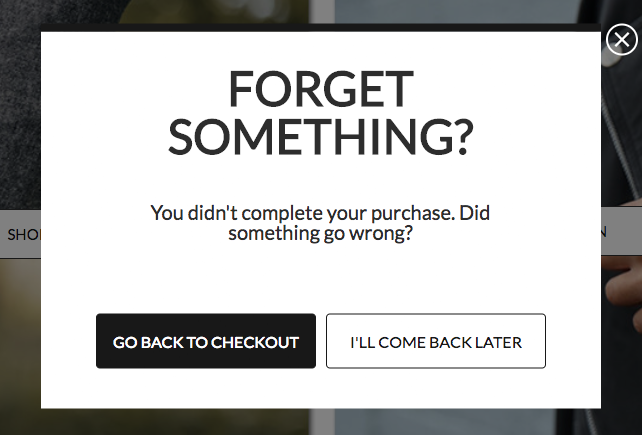
Ecommerce Marketing Strategy #16: Create a Shopping Cart Abandonment Email
With roughly 70% of all shopping cart additions failing to go through, addressing shopping cart abandonment is one of the fastest ways to grow your business.
Think about it…
- Let’s say you drive 1000 people to your website and get 100 of them to put something in their shopping cart. Let’s say that number is pretty static (though, of course, this guide is giving you ideas on how to improve that number).
- With a 70% shopping cart abandonment, you’re only getting 30 completed sales from 1000 visitors.
- Doubling down on ads might boost traffic by another 250 (a 25% increase). This will result in 7.5 more completed purchases.
- Addressing cart abandonment issues might enable you to decrease it from 70% to 52.5% (a 25% improvement). That would result in 47.5 purchases from the same 1000 visitors.
This is the power of optimizing the bottom of the eCommerce funnel.
And a shopping cart abandonment email is the most powerful way to convert that lost traffic.
You’ll have to be building your list (see the website popup strategies recommended above) to effectively send cart abandonment emails to prospective customers, but once you do you can start chipping away at that 70% which is hurting you so much.
Here’s an example of a cart abandonment email from Clearly eyewear after putting something in their checkout and leaving:

Note: You don’t have to have your products connected to your email platform to effectively use an abandoned cart email. Messaging like “Oops! You seem to have left something in your shopping cart. Click here to head back in!” is almost as effective. And this can be triggered based on pageview (viewed “checkout” but didn’t view “billing”) rather than any complicated, javascripted action.
Ecommerce Marketing Strategy #17: Create a “Hot Leads” List Using Marketing Automation
Contacting your prospective customers at the right time is crucial to getting them to buy. If they’ve provided their email address you need to be very careful with how frequently you email them. Too much and they’ll unsubscribe and you’ll have missed your opportunity. Not enough and they’ll forget you exist.
A great way to be sure that you’re only contacting prospective customers when they’re truly interested in buying is to create a category of subscribers: hot leads.
How you determine a hot lead is entirely up to you, though usually, it has something to do with their behavior within your website.
For instance, here’s how I’d add the hot lead property to a prospective customer within Wishpond’s eCommerce marketing automation platform:
First, set the conditions for your “hot lead” attribution. In this case, I’ve chosen “has viewed checkout twice in ten days:”

Next, set the actions which will be triggered when someone meets those conditions:
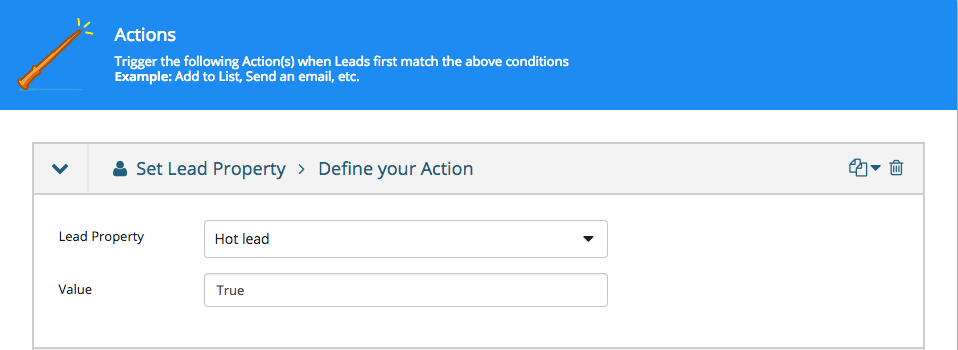
Now you can email everyone as soon as they become a “hot lead” with heavily-promotional content (which would otherwise be too overwhelming for subscribers less ready to buy).
Try something like…
“I see you’re really interested in a pair of Acme shoes! I don’t blame you; they’re pretty amazing. Did you know that, if you buy in the next 24 hours, we’ll ship them to you for free, and (if they don’t work out) you can ship them back at no cost to you?”
Ecommerce Marketing Strategy #18: Add Social Logins to Your Signup Page
Remember that graph I showed above, where eCommerce buyers were asked what put them off the most (the one where 27% of people didn’t like the complexity of the buying process)?
The top result on that graph is “the website wanted me to create an account.”
So here’s the problem: Your business needs visitors and customers to create an account so you can encourage them to complete a sale if they leave, encourage them to buy again down the line, and notify them of sales and promotions which are relevant to them. Account creation is a crucial part of a successful eCommerce marketing strategy.
Except that your visitors and customers don’t want to do it.
In fact, 86% of website visitors report being “bothered” by having to create a new account on websites. Nine in ten report that they will give false information or leave forms incomplete when creating a new account. 54% said they may leave rather than having to fill out an individual account creation form.
So what’s the answer?
Social logins.
The same study that reported that 86% of website visitors are bothered by creating a new account found that 77% “believe social login to be a good registration solution.”
For Wishpond (a big fan of social logins) our favorites are Facebook and Google, as they’re the most widely used.
If you’re going to add social login to your ecommerce website, it’s likely you’ll have to do so through an app/plugin. Head to the Shopify app store and do your research!
Ecommerce Marketing Strategy #19: Offer Live Chat
You don’t need to take my word for this one: offering live chat will help you sell more products online:
- 47% of online shoppers are more likely to make a purchase if they can talk to a live representative.
- 44% of online buyers say that getting their questions answered by a live representative is one of the most important features a website can offer in the buying process.
There are dozens of great live chat options for your eCommerce platform. The problem is staffing it.
My suggestion is to hire someone from a different timezone to cover. Though many live chat services have a “leave a message” option (which enables your business to review all messages which have been left while you were asleep), as a consumer it often feels like you’re more actively being ignored than if there’s no option at all.
Ecommerce Marketing Strategy #20: Drive Traffic to Campaign-Specific Pages Instead Of Your Home Page
If you’re running ads on Google or Facebook, you’ll be running specific campaigns (or you should be). You’ll be promoting your Spring sales or targeting people who type “buy men’s shoes” with a promotion for men’s shoes.
This is one of the #1 rules of eCommerce marketing: communicate your unique value proposition. What makes you stand out?
Whatever it is, your ads need to communicate it. And then, when people click on those ads, the page they’re being sent to needs to communicate the same thing.
As tempting as it is, the last thing you want to do when encouraging a sale is send people to your homepage. It’s not optimized to receive people interested in a single campaign.
Note: A hack around this (which will work to optimize your homepage itself) is to add the opt-in bar, entry popup or slide-in popup I recommended above. These work to feature your promotion. That said, if you have multiple campaigns running at the same time a landing page is still the best option to convert traffic at an optimal rate.
Here’s an example of a campaign-specific landing page I created using Wishpond’s eCommerce landing page builder:
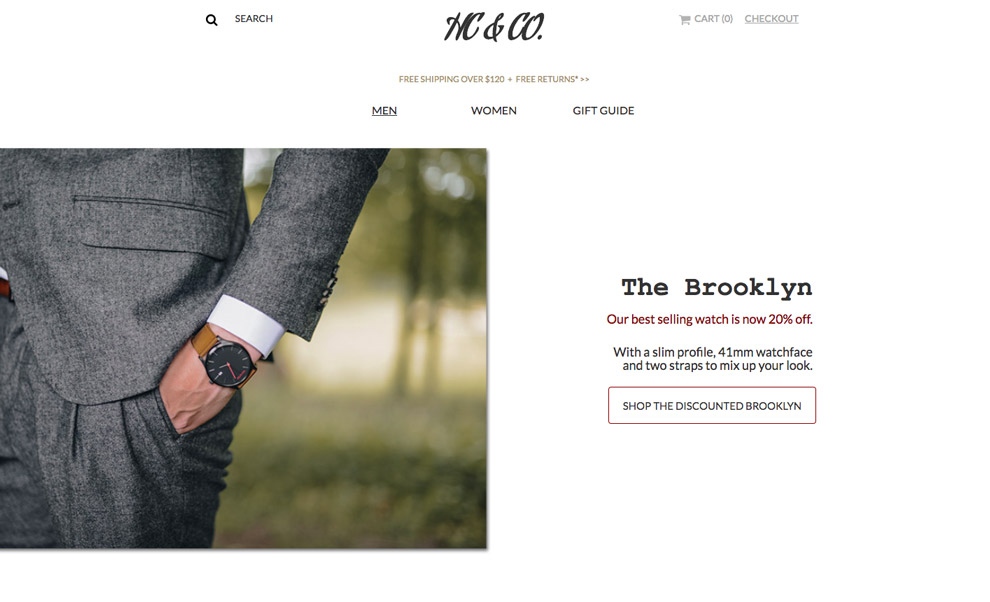
For more on this…
Ecommerce Marketing Strategy #21: Create Progressive Buying Funnels
Approximately a quarter of all ecommerce checkouts are abandoned because of an overly-complicated process.

The best way to grow your ecommerce business, therefore, is to plug up the holes in your checkout process. Here are a few strategies to do just that:
- Limit your checkout form fields. Where possible, collapse all optional fields like “Address 2.” Have a customer’s full name in only one field.
- Remove all web copy from your checkout page that doesn’t relate directly to the process. This is the same as when you’re creating a landing page or product page: nothing should be on the page which distracts the visitor from completing the objective (buying something).
- Limit the number of forms. Take a long, hard look at your process. Do you need everything you’re asking for?
- Separate billing information from mailing address (see example below).
- By default, have shipping information prepopulate with billing information, and add an “expand chevron” so people don’t see it when they first view the page.
Here’s an example of an optimized progressive checkout process from Crutchfield:

Ecommerce Marketing Strategy #22: Add Urgency to the Buying Process
A major reason that your customers don’t buy is because they’re lazy – not necessarily because they don’t see the value of your product or because they don’t have the money.
They need a push. They need a reason to buy today.
Here’s an example of added urgency from Sam’s Club:

Ecommerce Marketing Strategy #23: Segment Your Email List
The most effective way to turn previous customers into repeat customers is to prompt them to buy something you know they’re interested in – and that means segmentation.
The more specifically you segment your subscribers and customers, the better you’re able to drive future purchases.
For example, your eCommerce business could segment its customers by “people who bought men’s shoes” (assuming that everyone who buys men’s shoes is male, by the way, is a recipe for disaster), “people who bought women’s shoes” or leads from a contest.
Within your eCommerce marketing automation platform, that would look like this:

Then, when you had another sale on men’s shoes, you could send an email specifically to previous customers – thereby delivering content that’s relevant to them (and increasing the likelihood of them completing another purchase.
Ecommerce Marketing Strategy #24: Create Website Custom Audience Facebook Ads (WCAs)
Recapturing those people who abandoned their shopping cart (about 70% of your visitors, on average) is crucial to a successful eCommerce marketing strategy. You need to be doing everything you can to get those people back. Remember, these are people who wanted your product enough to put it in their shopping cart. Investing in driving them back is going to be worth the money.
Website custom audience ads are similar to remarketing or retargeting ads (which are also worth exploring), but if you’re already using Facebook Ads, the simplest option.
Essentially, the Facebook tracking pixel (which Facebook provides all advertisers when you set up your account) tracks people on your website to Facebook as well as from Facebook. This means you can show Facebook ads exclusively to people who left your website.
Here’s how it works:
Step 1: When you’re selecting your Facebook ad target audience, select “Custom Audience” and then “Website Traffic:”
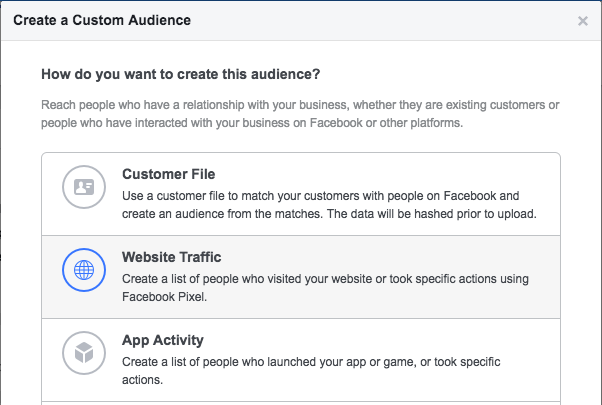
Step 2: Create your audience by including people who visited your website’s checkout page (URL equals “checkout”) and excluding people who visited your Thank You page (URL equals “thank-you” or equivalent):
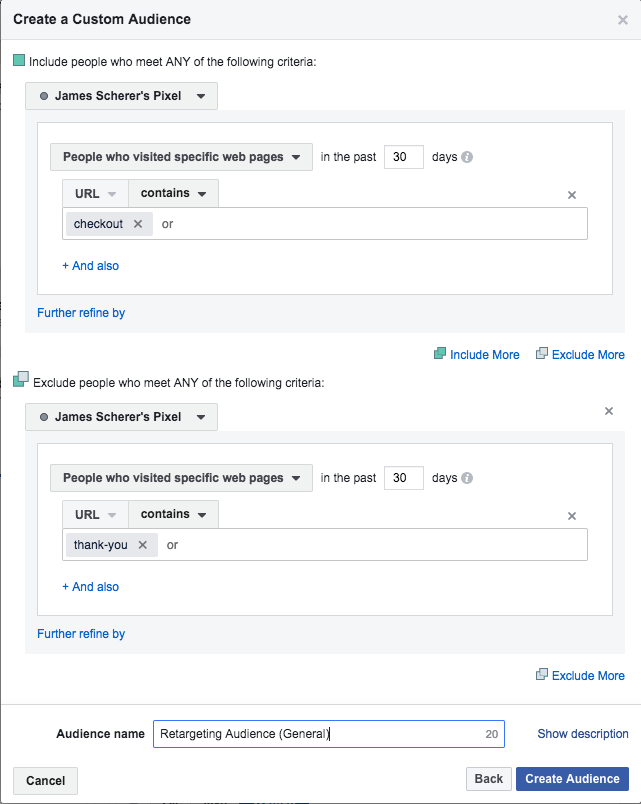
Ecommerce Marketing Strategy #25: Embed Your “Small Print” in a Click Popup
The last thing your product or billing pages need is more text. In fact, an optimized page should be as minimal as possible – offering only the information which prospective customers need to see the value, compare against competitors, and understand how to buy.
But, of course, you’re legally required (and it also builds trust) to have your terms and conditions and “satisfaction guarantee” documentation somewhere on your pages.
My recommendation, therefore, is to have links within your product pages that open a click popup that includes your information.
Below is an example from REI. Beneath their “add to cart'” button, they have a “100% Satisfaction Guarantee” link. When clicked, it opens a click popup:
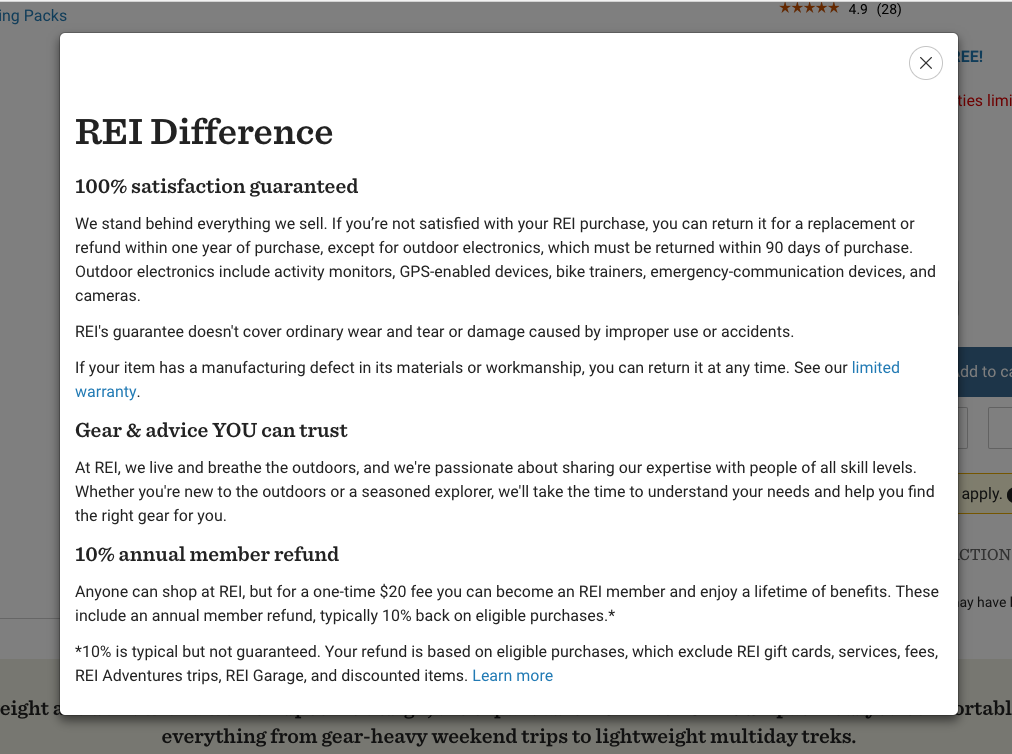
Ecommerce Marketing Strategy #26: Get Your Visitor’s Email Addresses
How many visitors do you get to your website each month? And how many of them buy?
If you’re like most eCommerce companies, you’re happy if 10% of your visitors end up completing a purchase.
Now, the strategies in this article can help you optimize your website and increase that percentage, but you’ll still lose the mass majority.
However, if you incentivize them (either through the promise of awesome content or a discount) to provide you with their email address, you have a bit more control of the situation.
An email address enables you to contact a prospective customer with promotions down the line. It enables you to contact them when they leave your checkout page without buying. And it enables you to prompt another purchase down the line if they do buy. And another after that.
Here’s an example of an entry popup that incentivizes email-opt in with a 15% discount as well as exclusive information (notice they’ve also asked for segmentation information, which will make it easier for them to deliver relevant content down the line):
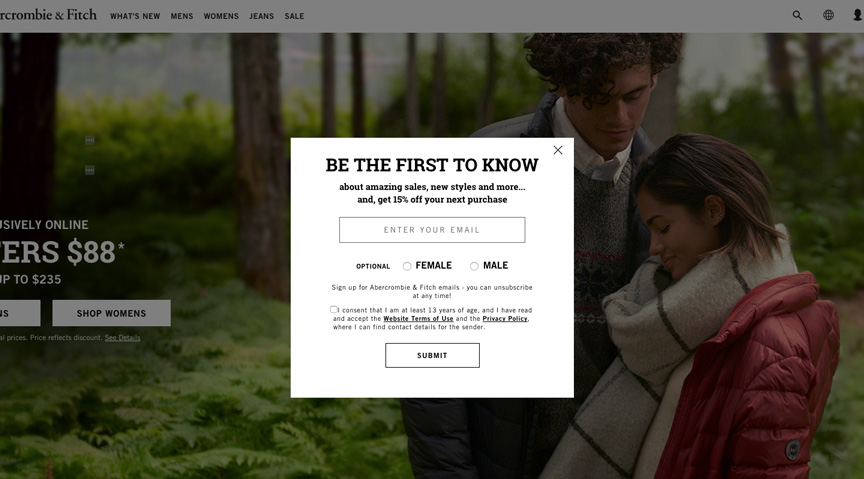
Ecommerce Marketing Strategy #27: Add a Negative Statement to Close a Popup
The strength of a popup is in the required action: visitors have to engage with your popup. They have to see your offer. Given that the majority of website “bounces” come from people who don’t understand or see the value, a popup is the best way to be sure that people see your value.
Making your “close” option a negative message then means that they don’t get to just say “no,” or “I didn’t see your value.” They have to actively click on “I don’t want this,” or (as is the case with the example from Greats shoes below), they have to actively “decline 10% credit.”
And that’s (subconsciously) more difficult to do.
Here’s an example of a negative statement within a popup from Greats shoes.
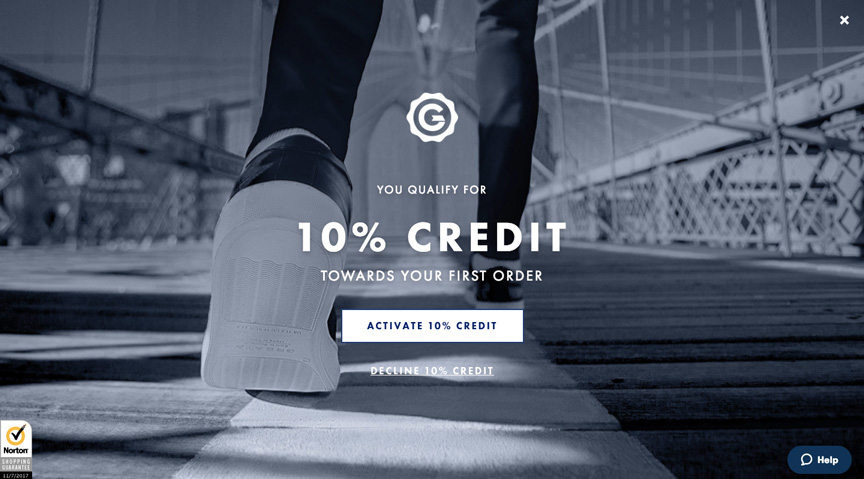
Ecommerce Marketing Strategy #28: Trigger a Text Messages Based on Website Interaction
This is a cool one (especially because text messages have a 98% open rate).
If you’re collecting the information from your prospective and existing customers, consider collecting their phone numbers as well as their email address.
A good eCommerce marketing automation platform will enable you to send a text directly to your prospective customers based on page visits, demographic information and more.
Here’s an example from Wishpond’s marketing automation campaign creator. The text message is sent via our integration with SMS service Twilio, and can be triggered in dozens of different ways:
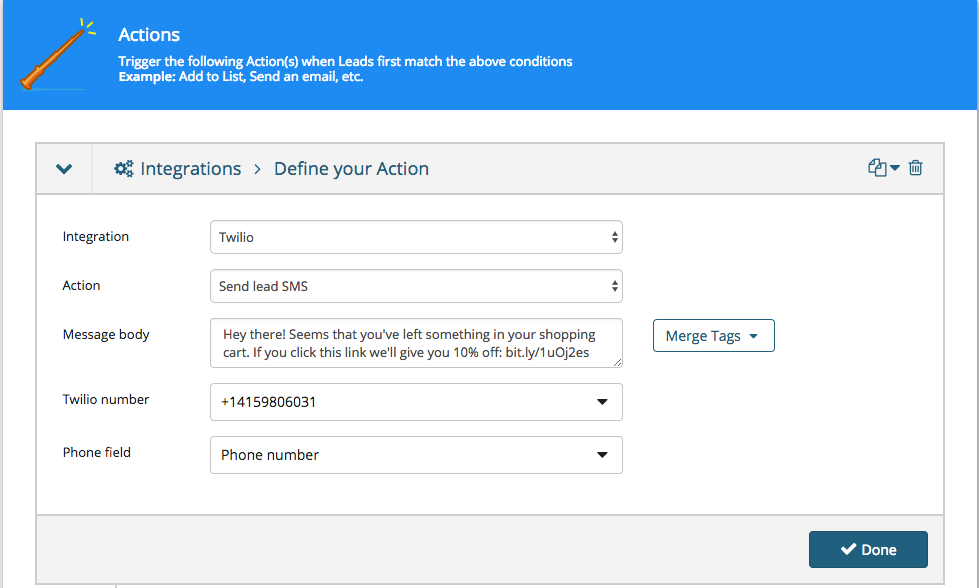
Ecommerce Marketing Strategy #29: Use Names and Liquid in Your Emails
Personalization is key in eCommerce marketing. If you know your customers’ (or prospective customers’) names, use them. If you know the products they were interested in, use them in your emails.
People like feeling that they have a personal relationship with the businesses they buy from. Being on a “first-name basis” with them will result in a longer, more profitable relationship. And knowing what they’re interested in (and talking to them about only that)
shows you care.
Here’s an example of an email that uses merge tags that I received from Intercom (a live chat platform, but the rule applies for eCommerce as much as it does software)

Another option (a little more powerful than merge tags), is Liquid. Liquid is a code that makes it easy for you to go above and beyond when personalizing your emails.
For eCommerce, it can be used to automatically insert a product name that has been left in a shopping cart. Or, if you want to personalize your emails but don’t know if you have the recipient’s name, you can use liquid to create an “if/then” statement.
It would look something like this:
{% if user.name %} Hey {{user.name}}, {% else %} Hey there! {% endif %}
By the way, liquid may work differently in different apps. Be sure to check with your developer before hitting publish.
For more on this…
Check out Shopify’s Liquid Walkthrough.
Ecommerce Marketing Strategy #30: A/B Test Everything
This last strategy is less of a single “strategy” and more of a “must-do for your business to succeed.”
If you’re not A/B testing your product pages, emails, homepage, and popups, you’re leaving money on the floor.
The idea that your first design or iteration of a campaign or homepage will perform at an optimal rate is foolishly arrogant. You can always do better.
Here’s the problem though, most early-stage eCommerce businesses (and even some of the later-stage ones) don’t have enough traffic for an A/B test to reach statistical significance in less than a year or two. So what’s the solution? You want to optimize your website and campaigns, but can never be 100% sure that something you’ve done is better.
Well, the first thing is that a test doesn’t actually have to reach 100% statistical significance for you to say it’s had a positive effect. In my opinion, you can call it at 70 or 80% if the test is based on common sense, proven best practices, or (simply) your own gut feeling.
What I just wrote is controversial, don’t get me wrong. But here’s the crux of it all for me: I’d rather you took steps to optimize your website than stayed frozen because you couldn’t reach 100% significance.
So long as your tests are based on a true understanding of your visitor’s experience; so long as you’re adding design elements and testing things which make sense, go with it.
And if you have any concerns, you can always ask someone who’s done it.
For more on all this…
For a complete guide to growing your ecommerce business online, check out “The Ecommerce Guide to Online Marketing: How to Drive Traffic, Get More Sales, and Keep your Customers Coming Back.”
Ecommerce Marketing Strategy #31: Start a Customer Loyalty Program
A customer loyalty program is a brilliant eCommerce marketing strategy to build up a base of satisfied customers that keep coming back for more.
With a good loyalty program in place, you’ll get more from your existing customers. This is far more affordable and effective than trying to acquire brand new customers with each sale.
For a successful loyalty program, you’ll need to make sure that you offer something of value to customers. This could be discounts for return purchases, points for writing reviews or referring friends, offering limited edition access to certain products, and more.

Successful loyalty programs need to be easy to join and easy to get rewards from.
Here are a few helpful tips to create an effective eCommerce loyalty program:
- Make the loyalty program available to anyone, even if they did not make a purchase. Rope them into the loyalty program with an email or push notification subscription instead.
- You can include various types of rewards in your loyalty program that aren’t just discounts or points. Things like free shipping, free products, and free consultations are all good driving forces.
- For the most effective loyalty program, run a survey and ask customers what types of rewards they want.
Ecommerce Marketing Strategy #32: Be Active On Pinterest
Pinterest is one of the best social media platforms for eCommerce marketing.
This is because Pinterest users have a seriously high buying intent. Loads of people go onto Pinterest specifically to find products and product ideas.
If you use your Pinterest account properly, you can send these people straight to your checkout page.
Add appealing images of your products to Pinterest and use this to drive traffic to your eCommerce store. You can even add product tags to your pins. This lets users click on your product image and get taken straight to the checkout page.
This is a great way to get people to discover your products and buy them all in the same browsing session.
Add your online store URL to your Pinterest profile, spend time writing engaging captions about your products, and create a range of different product boards to appeal to potential customers.
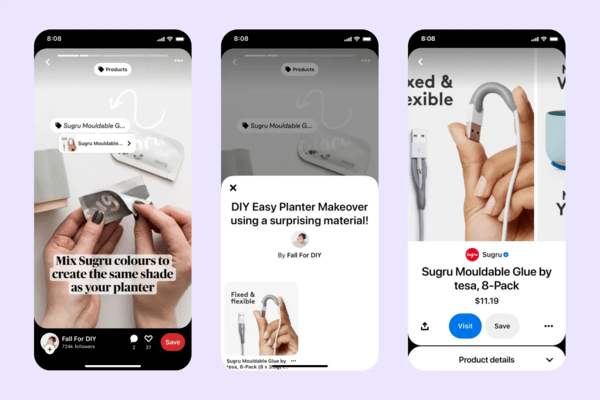
Image: Pinterest
Ecommerce Marketing Strategy #33: Set Up an Affiliate Marketing Campaign
Affiliate marketing is a powerful marketing strategy for any eCommerce store. This is when you get affiliates to promote your products for you, and you only pay them for successful sales.
The huge advantage of this is that you don’t waste any marketing budget. Affiliate marketing always offers a strong ROI, because you only pay for successful sales.
All you need to do is set up an appealing affiliate promotion, which includes paying a flat fee or a portion of each sale to an affiliate. Reach out to relevant affiliates, and open up your affiliate program to anyone who wants to promote your store.
Affiliates can be bloggers, influencers, YouTubers, or even celebrities. You won’t have to do any promotional work, and you won’t have to spend a cent until a sale is made. It’s the perfect marketing strategy for busy eCommerce store owners.
Just look at Amazon. They have the biggest affiliate marketing program, with millions of affiliates around the world promoting their products.
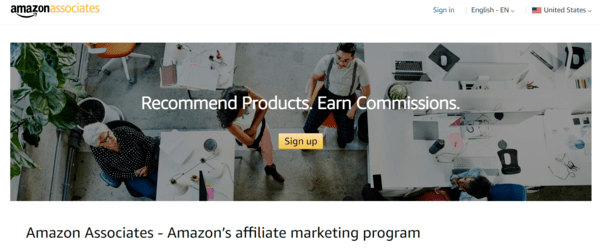
Ecommerce Marketing Strategy #34: Run a Social Media Giveaway
Product giveaways are one of the best strategies for eCommerce marketing. You can use giveaways to generate loads of buzz around your brand, increase brand and product awareness, and drive traffic to your store.
Ecommerce stores can also use product giveaways to go viral and generate valuable user-generated content. Just look at some popular TikTok contests, and you’ll see just how much attention the right #hashtag challenge can bring you.
Everyone who enters your giveaway is interested in your products, so they’re easy marketing targets. Once the giveaway is over, send out a 10% discount code to all entrants. Your product is on their mind and they wish they had won it, so a discount might be just the push they need to become a customer.
Running effective giveaways is easy with Wishpond. Try out the social promotions tool to see just how powerful these giveaways can be.
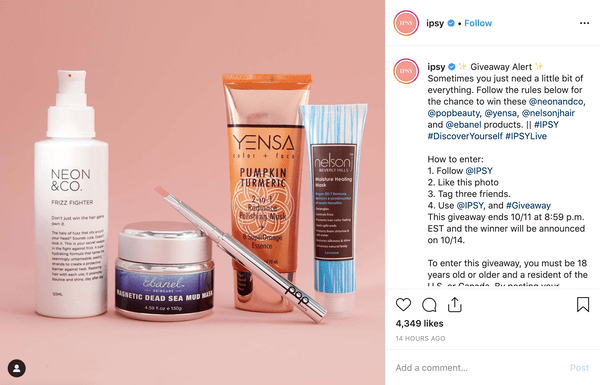
Ecommerce Marketing Strategy #35: Utilize Influencer Marketing
Influencer marketing is one of the biggest marketing trends for B2C brands right now. It also offers one of the best ROIs.
As an eCommerce business, influencers are one of the best ways to start selling to a bigger audience. Customers trust influencers more than they trust brands, and influencers have a lot more power over convincing their followers to make a purchase.
Influencers don’t have to be out of reach for small businesses. You can partner up with smaller micro-influencers to promote your products. These smaller influencers are often even more convincing and usually have a more engaged audience.
Make sure that the influencer you choose to work with shares the same target audience as your business. The great thing is that there are so many influencers out there, each appealing to a very specific niche.
It’s also a good idea to look at the influencer’s levels of engagement above their follower count. A smaller, more engaged following is much better than a large, unengaged following.
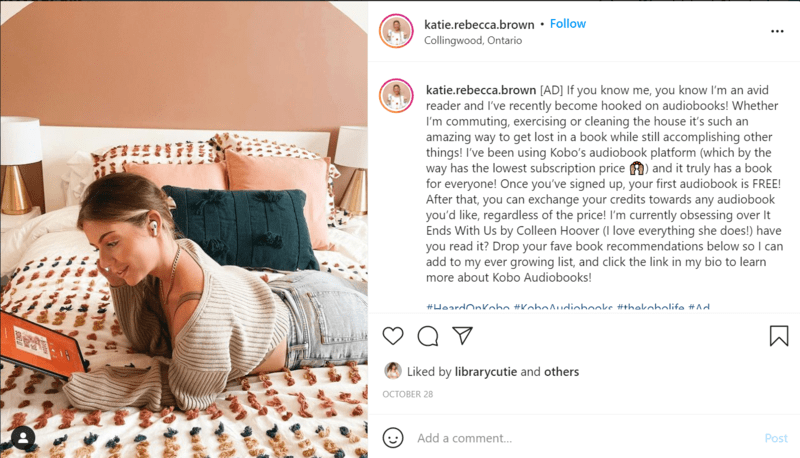
Final Thoughts
These eCommerce marketing examples have been tried and tested as some of the most effective strategies to use. Whether you’re a small brand just starting out, or an established eCommerce store, you can boost your sales by using these strategies.
If you have any questions, don’t hesitate to reach out in the comment section below!
Related Reading:
- The Ecommerce Guide to Online Marketing: How to Drive Traffic, Get More Sales, and Keep your Customers Coming Back
- How to Create a Marketing Campaign (That Actually Drives Sales)
- 23 Beautiful Ecommerce Landing Page Examples (2017)
- Everything You Need to Create a Winning Facebook Marketing Strategy
- 52 Facebook Marketing Ideas
- 50 Fun Contest Prize Ideas
- 21 Shopify Marketing Strategies You Need to Know


